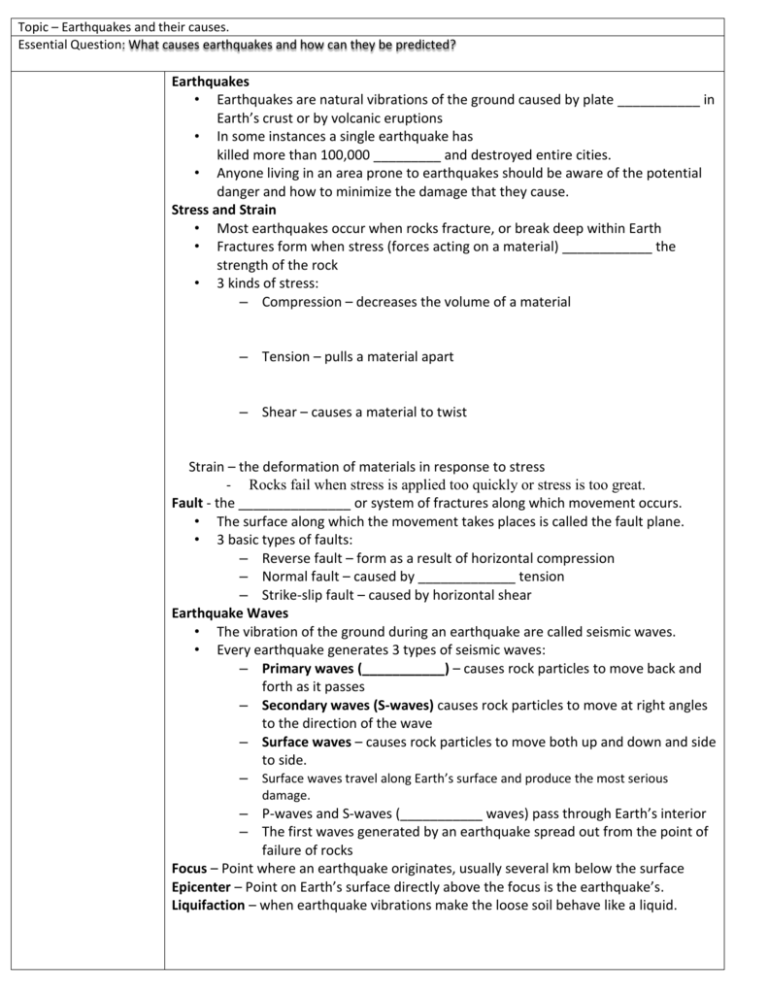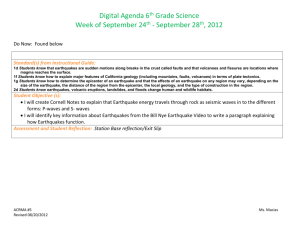Topic – Earthquakes and their causes. Essential Question: What
advertisement

Topic – Earthquakes and their causes. Essential Question: What causes earthquakes and how can they be predicted? Earthquakes • Earthquakes are natural vibrations of the ground caused by plate ___________ in Earth’s crust or by volcanic eruptions • In some instances a single earthquake has killed more than 100,000 _________ and destroyed entire cities. • Anyone living in an area prone to earthquakes should be aware of the potential danger and how to minimize the damage that they cause. Stress and Strain • Most earthquakes occur when rocks fracture, or break deep within Earth • Fractures form when stress (forces acting on a material) ____________ the strength of the rock • 3 kinds of stress: – Compression – decreases the volume of a material – Tension – pulls a material apart – Shear – causes a material to twist Strain – the deformation of materials in response to stress - Rocks fail when stress is applied too quickly or stress is too great. Fault - the _______________ or system of fractures along which movement occurs. • The surface along which the movement takes places is called the fault plane. • 3 basic types of faults: – Reverse fault – form as a result of horizontal compression – Normal fault – caused by _____________ tension – Strike-slip fault – caused by horizontal shear Earthquake Waves • The vibration of the ground during an earthquake are called seismic waves. • Every earthquake generates 3 types of seismic waves: – Primary waves (___________) – causes rock particles to move back and forth as it passes – Secondary waves (S-waves) causes rock particles to move at right angles to the direction of the wave – Surface waves – causes rock particles to move both up and down and side to side. – Surface waves travel along Earth’s surface and produce the most serious damage. – P-waves and S-waves (___________ waves) pass through Earth’s interior – The first waves generated by an earthquake spread out from the point of failure of rocks Focus – Point where an earthquake originates, usually several km below the surface Epicenter – Point on Earth’s surface directly above the focus is the earthquake’s. Liquifaction – when earthquake vibrations make the loose soil behave like a liquid. Measuring Energy Released and Locating Earthquakes • More than one million earthquakes occur each year! • More than ____% are not felt and cause little to no damage • The ones that make the news are major seismic events that cause much damage. Locating the Epicenter of an Earthquake In order to determine the ________________ of an earthquake, the earthquake needs to be recorded on three different seismographs that are at significantly different locations. The other piece of information needed is the __________ it takes for P-waves and Swaves to travel through the Earth and arrive at a seismographic station. Triangulation - A mathematical method for locating the epicenter of an earthquake using __________ or more data sets from seismic stations. Seismograph - Earthquake monitoring instrument that records the ____________ waves of the earthquake. Earthquake Magnitude & Intensity • The amount of energy released during an earthquake is measured by its magnitude. • Measured using the _____________Scale – based on the size of the largest seismic waves made by the quake 10-Fold (logarithmic) Scale: – meaning seismic waves of a magnitude-8 earthquake on the Richter scale are 10 times larger than a magnitude-7 and 100 times larger than a magnitude-6. • Most ____________ use the moment magnitude scale – takes into account the size of the fault rupture, the amount of movement along the fault, and the rock’s stiffness – Moment magnitude values are estimated from the size of several types of seismic waves produced by an earthquake. • Another way to assess earthquakes is to measure the amount of damage. • Modified ____________ Scale - measures the amount of damage done to the structures involved and is used to determine the intensity of an earthquake. • uses the Roman numerals I to XII to designate the degree of intensity. • Specific effects or damage correspond to specific numerals; the higher the numeral, the worse the damage. Depth of Focus • Another factor that determines a quake’s intensity is the depth of the quake’s focus – Can be classified as __________, intermediate, or deep – Deep-focus = smaller vibrations at epicenter – Shallow-focus = larger vibrations at epicenter • A shallow-focus, magnitude-6 quake will have greater intensity than a deepfocus, magnitude-8 quake • _____________ quakes with high intensities are almost always shallow-focus quakes Summary _______________________________________________________________________________ _______________________________________________________________________________ _______________________________________________________________________________ _______________________________________________________________________________ _______________________________________________________________________________ _______________________________________________________________________________









